Neon Genesis Evangelion (manga)

Neon Genesis Evangelion is a manga series by Evangelion character designer Yoshiyuki Sadamoto. It is an alternate retelling of the story of the Neon Genesis Evangelion TV series, constituting a separate continuity, with many subtle and obvious changes from the series on which it is based. The manga ran for almost two decades, and was serialized from December 26, 1994 to June 4, 2013 in Shōnen Ace (1994-2009) and Young Ace (2009-2013), and consisted of a total of 96 chapters and a bonus chapter spread across 14 Tankōbon volumes. The manga also ran before the series premiered and well after the series had ended, with its debut some 10 months ahead of the show's release in October 1995 thanks to delays in its production. However, after the early chapters Sadamoto, who prioritized other projects, maintained a very inconsistent release schedule, which caused multiple years-long hiatuses and significant portions of the story to be cut. As a result of this, the manga was only concluded some 17 years after the series' end in March 1996. Links to the summaries of each Tankōbon volume of the manga are listed below.
Unlike it is sometimes assumed, the manga is in fact not the original version of the story, but instead it was created as a supplemental designed to promote the TV series and was continued thanks to the series' popularity. Sadamoto has also repeatedly stated that the manga is his own individual work and should never be used as a reference for anything in the anime or the Rebuilds.[1][2][3] Sadamoto has also stated he made the manga entirely on his own, without consulting anyone, in contrast to the anime's more collaborative production.[4] He has also denied links to the Rebuild movies.[5]
| Manga Volumes |
| Volume 1 | Volume 2 | Volume 3 | Volume 4 | Volume 5 | Volume 6 | Volume 7 | Volume 8 | Volume 9 | Volume 10 |
| Volume 11 | Volume 12 | Volume 13 | Volume 14 |
Changes made from the anime series
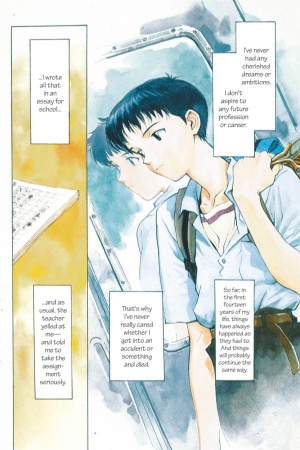
Plot changes
The plot of the manga follows the anime closely in its first half or so, with Sadamoto adding and changing significant elements in the second half. Most of the Action Arc is removed, as well as several Angels. The manga also features much less introspective, psychological and philosophical scenes.
- The manga's first chapter includes a scene from the Neon Genesis Evangelion Proposal that ultimately did not make it into the TV series, namely introducing the concept of Evangelions (and Rei Ayanami as a character) by showing one engaging in battle with the Angel, but having said battle ending with the Eva having to retreat after being outmatched. The scene is also altered a bit from how the Proposal described it, most prominently in how the Proposal's version had Rei piloting Eva-00 in the battle, but the manga has her in Eva-01 instead.
- Shinji acts more like the typical shounen mecha protagonist, with a lot more sarcasm and backbone than he ever showed in the anime. He is a lot more juvenile and less introspective than in the series.
- Shinji's past is also explored more in-depth, including interactions with his mother.
- Rei is also very different from her anime counterpart, even more so than Shinji. She comes across as more "human" than in the anime, opening up more to people through her complicated interactions with Shinji. The manga also displays more of Rei's thoughts and feelings, and even points towards some sort of affection for Shinji, perhaps even beyond the affection of just friendship.
- Asuka is markedly more childish, and her "popular" façade is more pronounced. In particular, she puts on more of a show for the adults as a proper, responsible girl. She is more self-centered and is somewhat less aggressive towards Shinji but still teases him a lot, and he is still interested in her and Rei, just like the anime.
- Gendo is by and large made more openly villainous and antagonistic. He is markedly more verbally abusive towards Shinji, culminating in him telling his son that he resents him, as he see him as competitor for Yui's affection. Rather than wanting to use Instrumentality to fulfil his desperate wish to be reunited with Yui, like his anime counterpart, he is instead driven by megalomania and revenge, wanting to gain the power of a god so he can take his anger out on the world, which he blames for taking Yui from him. It is also heavily implied that he murdered Kaji in this version of the story, rather than a henchman sent by Seele or Nerv.
- Pen Pen is given a backstory; he was a penguin that was being experimented on, and was rescued by Misato.
- Shinji runs away because he finds a journal Misato had been keeping, which detailed Shinji's behavior while she was watching him.
- Shinji, along with Toji and Kensuke, are not present for the fight with Gaghiel; Shinji watches it on tape at NERV HQ, and Asuka defeats the Angel by herself.
- As such, the circumstances of their meeting are changed: Shinji meets Asuka at an arcade, where he, Toji, and Kensuke watch her beat up some men.
- Toji is far more antagonistic and abusive towards Asuka, referring to her as a "bitch" several times. His Kansai dialect and "country manners" are also expanded upon.
- Kensuke is smitten with Asuka, however, he never mentions it to her, and Asuka remains apathetic towards him.
- Hikari approaches Shinji to ask for help in regards to Toji
- Shinji is also aware of Toji's status as the pilot of Eva-03 before the battle, as Toji made sure to tell him.
- Toji dies in the battle, as opposed to surviving with a missing leg.
- Thirteen of the Seventeen Angels are used, with the Lilin being the final Angel encountered, much like EoE.
- Sandalphon, Matarael, Ireul, and Leliel are entirely absent.
- Sahaquiel is present, but is not included in the numbering scheme used in the manga from that point onwards.
- Kaji is much more present in the manga than in the anime, giving Shinji a lot more advice, and being there for Shinji on multiple occasions, including just before the battle with Zeruel. It is also made very clear that he is dead in the manga with him embracing his dead brother's spirit, as opposed to the anime's more ambiguous scene depicting his death.
- Kaworu appears much earlier than in the anime, as a replacement pilot for Eva-02, when it appears that Asuka's synch ratio is dropping too low. This pushes Asuka to fight Arael in order to show she can still fight. He is much more alien and aloof than in the series, and Shinji constantly tries to avoid him.
- Kaworu is also present for the fight with Armisael, after becoming Eva-02's pilot.
- Like in the anime, in the manga Shinji shows no sexual attraction to Rei. But he is able to define their relationship when he says "What I feel for Ayanami, it doesn't go with words...like 'like' and 'want to go out with.' It's as if she's a part of me that was torn away a long time ago." (Volume 5 of the manga)
- After Kaworu's death, Shinji openly acknowledges his need for human interaction and the bonds that come along with it, and exhibits his despondency when those bonds are severed. For example, when Shinji heads to see Asuka in the hospital he says, "The Asuka I want to protect isn't this empty shell!" Meaning, Asuka's distance from him represents the completion of his social estrangement, not that he had sexual feelings for her, which is a clear contrast to his masturbating over Asuka's body in End of Evangelion. Asuka then wakes up from her coma and attempts to strangle Shinji before she is subdued (where she proclaims her hate for everyone). After this, the manga begins to loosely follow End of Evangelion.
- However in a change from EoE, Asuka is not brutally dismembered as she was, with Shinji arriving just in time to protect her and fulfill his promise to Misato.
- Unlike End of Evangelion, Shinji is rescued from the JSSDF by Gendo; Misato only shows up later to escort Shinji.
- The ending is drastically different, with the beach scene of Shinji and Asuka from EoE replaced with what appears to be a world where the Evangelions only existed long ago, with petrified Mass Production Evas treated as "relics", possibly eons after the events in the manga, or another reality entirely.
- The overall ending is more less open-ended as well, with Shinji looking forward to the future.
- On relationships, Sadamoto likens Rei to a "motherly existence", Asuka to [Shinji's] "longing for the opposite sex"[6] and Kaworu as that af high school student causing an impression on a younger, middle-school one, "not romance"[7], though Shinji ultimately rejects him.[8]
Changes in character backstory
- Shinji Ikari - Instead of living with his sensei for the years after Yui's death, Shinji lived with his aunt and uncle. From Stage 90, it is made clear that his relatives are Yui's relatives, but it is left unknown from dialogue whether his aunt or uncle are the sibling of Yui.
- Asuka Langley Soryu - Asuka was a test-tube baby, instead of being the child of Kyoko and Langley. Kyoko remains her mother, however, and the rest of her story remains similar.
- Ryoji Kaji - Kaji is given a backstory in the manga. He lived with many children on the streets, stealing food to survive after Second Impact.
Character design alterations
- Shinji Ikari - In the anime series, Shinji is always depicted with dark brown hair and dark blue eyes. However, in the manga, Shinji has black hair and brown eyes.
- Asuka Langley Soryu - In the anime, Asuka has dark red hair. In the manga, she has strawberry blonde hair.
- Kaworu Nagisa - Kaworu's hair and face became thinner and more angular, more mature in a way. His hair is shorter and silver-colored, as opposed to a lavender gray. His pupils are more prominently depicted than they are in the anime.
- Toji Suzuhara - In the anime, Toji was depicted with black hair. In the manga, he has light brown hair.
- Shigeru Aoba - His hairstyle is slightly different.
Supplemental material
- In the Japanese volumes of the manga there is usually an interview with one of the production team who made, or were otherwise involved in, the television series.
- At the end of each volume a 4-koma called Angel Kiss was usually present.
- This supplemental material was translated and published by Viz Media in their special edition release of Sadamoto's manga.
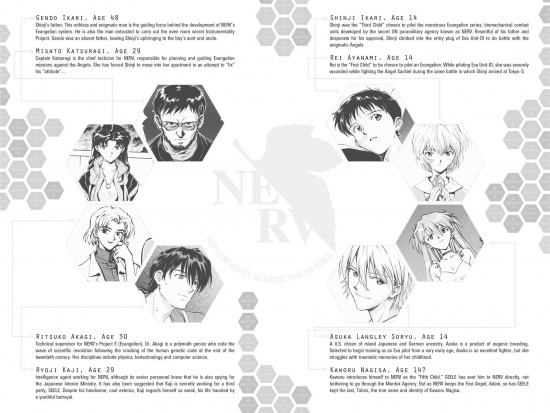
| Manga Artwork | ||
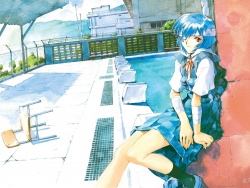 |
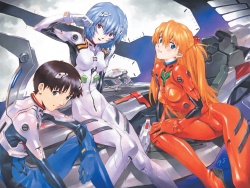 |
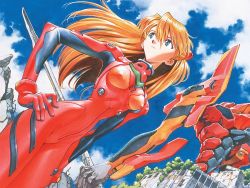 |
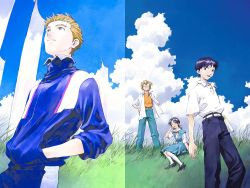 |
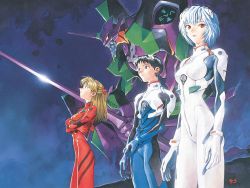 |
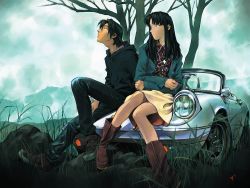 |
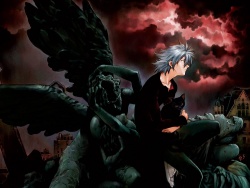 |
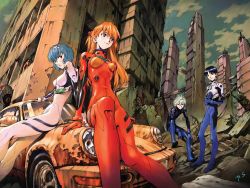 |
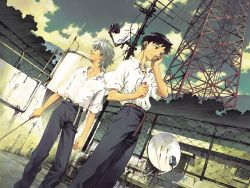 |
|
All artwork by Yoshiyuki Sadamoto | ||
Publishing history
The manga ran from December 26 of 1994 to June 4 of 2013. The reason for this is that while ostensibly publishing one "stage" a month in Shōnen Ace, Sadamoto's actual publication schedule was irregular: for example, between the publication in Japan of volume 4 and volume 5, two years elapsed.[9] (Volume 5 consisted of stages 27–29, published in January, March, and May 1998, with a year-long hiatus,[10] then stages 30–33 were published between July/October 1999.) This would only get worse in the 2000s, with multiple years-long hiatuses. In 2016, Sadamoto said he just wanted to finish his involvement in the franchise.[11] Apparently, Sadamoto's authorship of the manga caused problems for Gainax as multiple publishers felt "that he was too passé to be bankable".[12]
Notes
- Mari shows up in the bonus chapter of the final volume as a college schoolmate of Yui and Kyoko, who is smitten with Yui, and jealous that she is in a relationship with Gendo.
- ↑ " A: I think that the theme of the animated version is that the main character's attitude changes little by little. I think that in the anime, Anno wrote the script in his own words, and that is why the change occurs. And the reason for the subtle changes between the animation and the manga is that Yoshiyuki Sadamoto is writing the script using Anno's characters. I think the anime is...I can't say cuter. But it has the feel of an honors student. The manga is a little more twisted...the feeling of a flunk-out. I think the reason behind this is that Anno was his class president in elementary and junior high schools, and flunking out was something he couldn't do, whereas I never had that problem. (laughs)"
[...]"Q: Concentrating on the story, where do you think the biggest difference is between the manga and the anime? A: Well I did write the script of the manga using the anime as a base. " - Sadamoto's "My Thoughts at the Moment", 1996
- ↑ "Thank you. But that being said, you can’t use the manga to complement the Anime. This manga is just what I draw when I thought “it is should be like this, right?” Nothing more, nothing less."
"No, unlike Anno, I don’t have a life worth telling.(laugh) Perhaps I won’t express myself overall……But I can’t just copy Anno’s work. In this condition, I have to come up the theme myself, try to use different methods to describe. Every version of EVA has a different ending, I think the manga will have a different ending, too. As a work, entertainment is more important, so I can’t make the work same as the anime. But if I make the manga something completely different, then it can’t be called EVA. So not too close, not too far away. Rebuild is in the same position." - All About Kaworu Nagisa interview with Sadamoto - ↑ "This time, I tried to keep the celluloid images for animation and the painted illustrations for manga quite separate from each other. I wanted to have the animation staff draw the celluloid images. I separated the animation from the manga. They complement each other, or at least they complement each other's weaknesses, so (at least in my mind) I tried to avoid drawing celluloid as much as possible this time." - Sadamoto Saturn Illustrations
- ↑ "As for the Evangelion manga, Sadamoto claims to have made it entirely by himself, without consulting with anyone, so any differences with the anime were all decided solely by him; this is in contrast to the anime where all decisions were made as a group, all sitting in the same room and arguing." "Sadamoto replied in the negative, as his only work as a mangaka is nothing more than a reworking of a pre-existing work." Milano Manga Festival: Reportage dei Sadamoto Days
- ↑ Interview with Sadamoto, includes his confirmation that the Mari bonus chapter was just fanservice Next question is about Evangelion Rebuilds, do you know about the symbol of the last movie (repeat sign in music)? Sadamoto: Just to start, I’d like to clarify my position on the Rebuilds. I’ve only done the main character designs so… (laugh) Ah I see. It’s this (shows the symbol of Rebuild 3.0+1.0). We weren’t even able to read the title. Sadamoto: (looks) Right, I’m sorry but it’s the first time I see it, to tell you how little my implication is. [...] A question about the Evangelion manga, were you completely free on the script or were you consulting director Anno? Sadamoto: There isn’t any script. When you make anime there are the storyboards, right? We were just sharing them, so I’m on the same level as a fan. I just wrote it on my own, looking at the storyboards. So I didn’t consult anyone, and of course no one from the TV series’ staff intervened in my manga. So, in the last page of the manga there is Mari, one of the Rebuild’s characters… Sadamoto: Oh, that’s not in the storyline, it’s just an extra chapter for the manga volume. It’s even apart from the movies, like fanservice. Just something you mustn’t think too hard about. (laugh) It’s just something that went through my mind, I thought it would be funny if it were like that. I see. So it was not a request? Sadamoto: It wasn’t and… since she appeared in Jo, Ha and Q, I wondered what her role in the story would be, and when I asked the staff, they told me that it won’t be possible to really go further in one film, so they had to tie the main story up, and that Mari may have almost no screen time. So I wondered what the point was, and decided to add a little bit of her story in the manga, on impulse. So it’s really not something the staff of the movies thought about or asked me to do, just something you can consider as a play of mine. I see, since you know, fans tend to read deep into that kind of thing. Yamaga: Yeah, particularly on Evangelion. They think every little detail has a meaning. (laugh) Sadamoto: Well, but of course when we see Mari in Jo or Ha and see her call Gendo Gendo-kun or smell Shinji’s odor, she’s doing many strange things. Besides she seems to like songs of the Showa era very much since she’s singing them. [...] But again, it’s only me imagining all this. (laugh) Has director Anno decided about that? Sadamoto: Like I said, director Anno hasn’t approved or refuted that idea, he has nothing to do with what I just said.
- ↑ Sadamoto, Newtype December 1997
- ↑ - All About Kaworu Nagisa interview
- ↑ Milano Festival Days 2014
- ↑ "You've been anxiously waiting for two years! Vol. 5 is finally here! First, I'd like to give a heartfelt "thank you" to those of you who bought this book and are reading it now. I know you kind souls won't ask any questions about why it is so late, and will wait just as patiently for Vol. 6. Yes... I know you'll wait. I think you'll wait. Probably." (Emphasis in the original. Author's note in Viz's volume 5, ISBN 1-59116-403-6).
- ↑ http://www.ex.org/news/1999_05.html
- ↑ After all these years working on , how do you feel about the series?'
As an anime industry worker, for me has been just another job, and I need to get work apart from to keep going. It's a I don't really want to work on anymore at this point – but it's an important in Japan and there are many fans, so I take it seriously. He has not returned to work in the final Rebuild movie. - Interview: Legendary Evangelion Illustrator Yoshiyuki Sadamoto, ANN - ↑ pg 167 of Takeda 2002.
